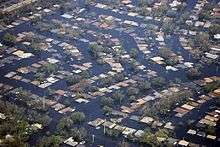Disaster Relief Act of 1974
.svg.png) | |
| Long title | An Act entitled the "Disaster Relief Act Amendments of 1974" |
|---|---|
| Acronyms (colloquial) | DRAA |
| Nicknames | Disaster Relief Act Amendments of 1974 |
| Enacted by | the 93rd United States Congress |
| Effective | April 1, 1974 |
| Citations | |
| Public law | 93-288 |
| Statutes at Large | 88 Stat. 143 |
| Codification | |
| Titles amended | 42 U.S.C.: Public Health and Social Welfare |
| U.S.C. sections amended | 42 U.S.C. ch. 68 § 5121 et seq. |
| Legislative history | |
| |
The Disaster Relief Act of 1974 (Public Law 93-288) was passed into law by the then President Richard Nixon as a United States federal law that established the process of presidential disaster declarations.[1] It was to better handle the array of disasters that occur annually throughout the 50 states. At one point, more than one hundred federal agencies were involved in handling disasters and emergencies. The Act also helped give more fixed relief to disaster survivors.
Amendments
In 1979, President Jimmy Carter consolidated many of them into the new Federal Emergency Management Agency (FEMA) by Executive Order 12127.

In November 1988, the United States Congress amended the Act and renamed it the Stafford Disaster Relief and Emergency Assistance Act (Public Law 100-707).[2][3]
This act was further amended by the Disaster Mitigation Act of 2000.[4]
References
- ↑ "149 - Statement About the Disaster Relief Act of 1974". www.presidency.ucsb.edu. Retrieved 27 November 2012.
- ↑ "Robert T. Stafford Disaster Relief and Emergency Assistance Act (Public Law 93-288) as amended". FEMA. Retrieved 27 November 2012.
- ↑ "Disaster Relief Act". www.investopedia.com. Retrieved 27 November 2012.
- ↑ "Robert T. Stafford Disaster Relief and Emergency Assistance Act, as amended by Public Law 106-390, October 30, 2000". www.disastersrus.org. Retrieved 27 November 2012.